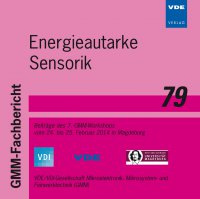SMART Implant: Electronic Implants for Diagnosis and Monitoring
Conference: Energieautarke Sensorik - Beiträge des 7. GMM-Workshops
02/24/2014 - 02/25/2014 at Magdeburg, Deutschland
Proceedings: Energieautarke Sensorik
Pages: 3Language: englishTyp: PDF
Personal VDE Members are entitled to a 10% discount on this title
Authors:
Stett, Alfred; Bucher, Volker; Cihova, Martina; Gutöhrlein, Katja; Kubon, Massimo; Link, Gorden; Metzen, Rene von; Stamm, Boris; Stelzle, Martin (NMI Naturwissenschaftliches und Medizinisches Institut an der Universität Tübingen, Reutlingen, Germany)
Pojtinger, Andreas; Schneider, Katharina (2E mechatronic GmbH & Co.KG, Kirchheim, Germany)
Mintenbeck, Dieter; Rossbach, Daniel (HSG-IMIT Institut für Mikro- und Informationstechnik, Villingen-Schwenningen, Germany)
Richter, Harald; Nawito, Moustafa (IMS Institut für Mikroelektronik, Stuttgart, Germany)
Boven, Karl-Heinz; Möller, Andreas; Jeschke, Christoph; Pätzold, Jens (Multi Channel Systems MCS GmbH, Reutlingen, Germany)
Göttsche, Thorsten; Bludau, Oliver; Haas, Nora; Tompkins, Dana (Osypka AG, Rheinfelden, Germany)
Lebold, Timo; Kokelmann, Martin (Retina Implant AG, Reutlingen, Germany)
Abstract:
Electrical implants like cardiac pacemakers and neuroimplants basically consist of a solid metal housing protecting the electronics and the energy storage. For applications, where only a small volume is available for inclusion of the implant like in the eye, ear and brain, and where cabling is not applicable, miniaturized and cable-less implants are required. The SMART IMPLANT consortium in the Spitzencluster microTEC Südwest develops highly-integrated implantable systems for in vivo biosensor applications. It contains amperometric, potentiometric and impedance sensors allowing the electrochemical measurement of the oxygen concentration, the pH-value and the impedance in the vicinity of the implant. The implant system consists of ASICs (application specific integrated circuit) and microcontrollers for sensor readout, inductive power transmission and bidirectional data transfer, SMD devices and a rechargeable battery. The whole system will be wrapped either in a flexible thin-film encapsulation or in a sealed PEEK housing to protect the electronics from body liquids. In order to enable miniaturisation of the implants with high functionality the electronic circuits are optimized for energy efficient operation. The implants aim at applications in diagnosis and therapy of neurological and metabolic disorders.


